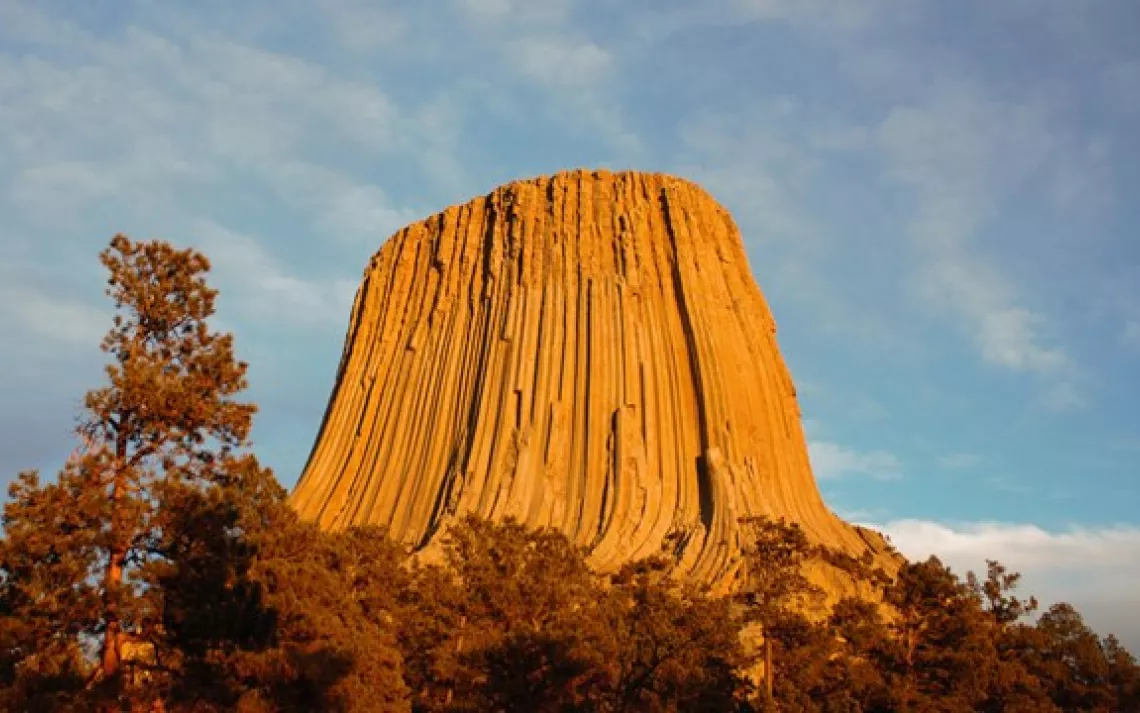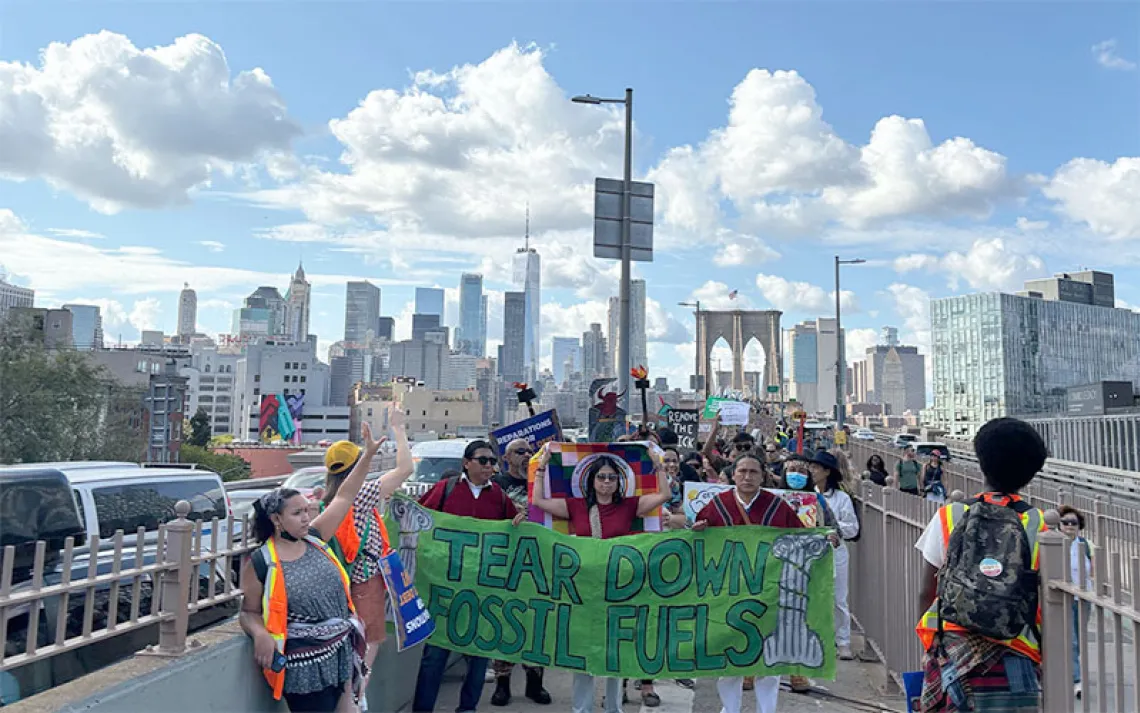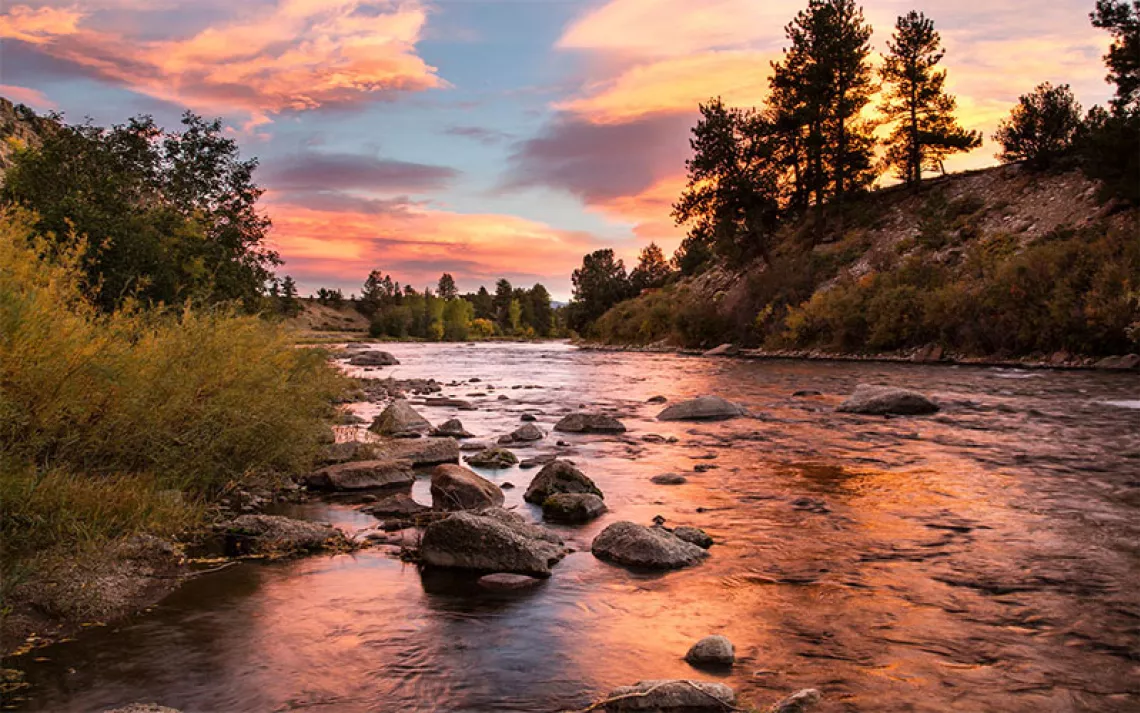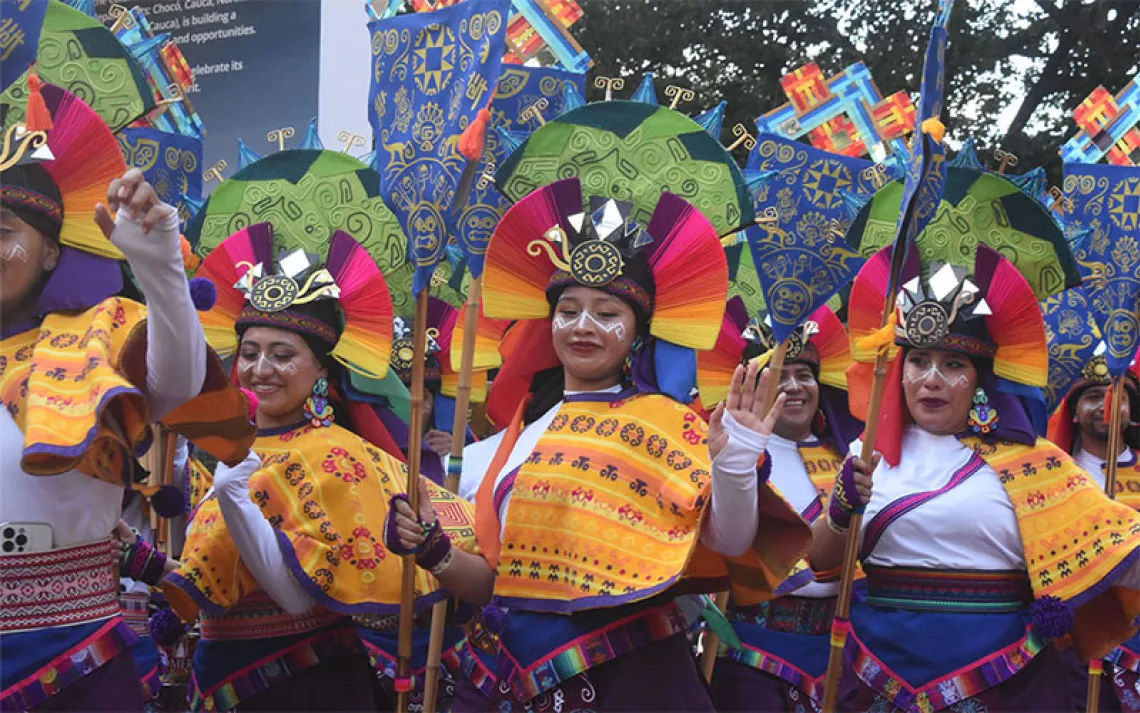Sacred Landscapes
To developers they’re just piles of rocks. To Native Americans, they’re places of worship.

Devils Tower | Photo courtesy NPS.
Last summer, more than 10,000 sheep, horses, and cattle perished in the Navajo Nation as one of the most severe droughts in the last century seared the American Southwest. It was a time of great hardship, and many families prayed every day for rain–to water their livestock and crops, to fill dry lakebeds and dams, and to nourish remaining foliage and forests.
Water is sacred to the Diné, or Navajo people. Water is life. We are taught that if we honor our spiritual responsibilities to Ni’hima Nahasdzaan (Mother Earth) as instructed by our ancestors, we ensure there will be adequate blessings of water for survival. If not, there will be hardship.
The Diné holy people long ago warned against destruction of the natural world. Certain sacred places, they told us, must never be disturbed. These places, and certain elements, are interconnected and interdependent through reciprocal relationships that are a model for humans to follow. Life, they said, cannot exist out of balance.
"Our ancestors taught us that if we lose respect for the gods, our clan relationships, and the sacred, we may face starvation, drought, disease, and other catastrophes, just as it happened to the people before us," says Alfred W. Yazzie, a well-known hataalii’, or medicine man. He fears the dominant society’s greed is leading to a world out of balance, where everything we can see, smell, touch, and taste is commodified and sold. In his lifetime, he has watched the places where he goes to pray, gather medicine plants, and make offerings to the deities be devoured by development in the name of "progress."
A hundred miles away from Yazzie’s home in Fort Defiance, Arizona, Hopi elders and activists are also concerned about sacred springs, streams, and wells that are drying up. They blame Peabody Energy’s massive coal mine, which pumps 1.3 billion gallons of water each year from the aquifer underlying both Hopi and Navajo land. The water is used to move crushed coal in underground slurry lines 273 miles from Black Mesa in northern Arizona to a Nevada power plant that fuels the bright lights of Las Vegas, Phoenix, and Los Angeles.
Under the banner of the nonprofit Black Mesa Trust, the Hopi are working with a coalition of other tribes and environmentalists, including the Sierra Club and the Natural Resources Defense Council, to protect their land, water, and culture. They know from bitter experience that it takes more than their pleas and prayers to save what they hold holy. It is a constant struggle for the Hopi and other tribes to retain access to and protect sacred sites that exist in certain mountains, rivers, forests, springs, canyons, mineral deposits, rock formations, lava tubes, craters, and areas where spiritual events occurred or medicines grow. As an increasing population puts greater burdens on the land, many of these sacred places are destroyed or damaged by logging, mining, farming, dams, or other resource-development ventures. The Native worldview of the land as a living, breathing entity is ill understood by those who think of the natural world as real estate to be carved up and sold.
Hopi religious leaders spent the past decade, for example, trying to stop the destruction of sacred shrines at Woodruff Butte, a cinder-cone peak near Flagstaff, Arizona. Tsimontukwi, named after the tsimona plant, was one of nine important pilgrimage shrines that mark the boundaries of Hopi territory. For more than 1,000 years, Hopi people had journeyed to the butte to gather eaglets for ceremonies, to pray for rain, and to collect healing plants.
But in 1990, a private landowner decided to grind Woodruff Butte into gravel to supply asphalt for Interstate 40, which crosses the homelands of a dozen tribes in the Southwest. When Hopi people objected, he offered to sell the property for $1 million, an amount they could not afford. So the gravel mining continued.
In 1996, Woodruff Butte was sold to a new owner, Dale McKinnon. "I didn’t realize I was destroying anything but a big ugly pile of rocks out in the middle of nowhere," McKinnon told filmmaker Christopher McCloud in the award-winning documentary In the Light of Reverence. "When the Native Americans came with their concerns, I had to take a step back and I tried to put myself in their position. And realizing that I can’t totally agree with them for my own religious reasons and beliefs, I was willing to make a compromise." His "compromise" was to raise the selling price to $3 million.
The tribe employed the National Historic Preservation Act to stop the destruction and to conduct a cultural-resources inventory, which should have documented the religious significance of the area. However, the archaeologist responsible for conducting the survey inexplicably failed to make note of any shrines in his report to the court. The quarrying continued. "We literally saw one Hopi shrine bulldozed," says Leigh Kuwanwisiwma, Hopi cultural-preservation officer, in In the Light of Reverence. He likened it to "Hopis going into Woodruff and bulldozing part of the Mormon church."
When the top of the butte was pulverized to make gravel, it destroyed nearly all of the Hopi clan shrines, along with eagle nests that once rested there. Today, tourists traveling I-40 to see Indian country have no idea they’re driving on lost Hopi heritage.
"Sacred landscapes are not sacred because Native people believe they are. They are sacred in and of themselves. Even if we all die off, they will still be sacred," says Chris Peters, a Pohlik-lah tribal member and director of the Seventh Generation Fund, a Native advocacy foundation based in Arcata, California. "Over the course of time Native people have grown to understand there is power in these places–power that is significant to the entire ecosystem of all living things. The Earth is sacred and needs to be protected, and we as humans need to take responsibility to live in a sustainable way."
Many tribes have origin stories that define traditional cultural sites or places of reverence, which Native people have depended on for millennia for cultural vitality and spiritual sustenance. Rich oral histories are passed down to younger generations through ceremonial songs and rituals embedded with instructions for how they should live with respect for natural laws and Creation.

Sign up to receive Sierra News & Views
Get articles like this one sent directly to your inbox weekly.
With this action you affirm you want to receive Sierra Club communications and may vote on policy designated by the Sierra Club Board.
Dr. Henrietta Mann, a member of the Cheyenne tribe and endowed chair of Native American studies at Montana State University, explains: "Over the time we have been here, we have built cultural ways on and about this land. We have our own respected versions of how we came to be. These origin stories–that we emerged or fell from the sky or were brought forth–connect us to this land and establish our realities, our belief systems. We have spiritual responsibilities to renew the Earth and we do this through our ceremonies so that our Mother, the Earth, can continue to support us. Mutuality and respect are part of our tradition–give and take. Somewhere along the way I hope people will learn that you can’t just take, that you have to give back to the land."
Mann estimates that more than 75 percent of tribal sacred sites are now unavailable to Native peoples, who saw some 90 million acres taken by the U.S. government–without compensation–between 1887 and 1934. "We’ve lost ninety-eight percent of our land base, so what’s wrong with keeping our sacred sites from development?" she asks. "When you are talking about Earth-based spirituality, the whole erosion of our land base threw us into cultural chaos. Without the land there is no sovereignty, without sovereignty there is no relationship, and without relationship there is no responsibility to the Earth."
During the 1990s, Native Americans made progress in securing protection for many sacred places. A string of recent decisions by the Bush administration, however, has overturned these gains, as Native Americans’ religious liberty is traded for the profits of resource-extraction industries.
In Southern California, for example, the Quechan tribe has fought for years against a proposal by the Canadian mining corporation Glamis Gold to dig a 1,600-acre mine at Indian Pass, where cyanide solutions would be used to extract gold from low-grade ore. This off-reservation site, controlled by the Bureau of Land Management, is covered by Quechan "Dream Trails" where tribal members seek visions. Glamis’s vision is for an open pit 88 stories deep, where every 280 tons of rock would yield one ounce of gold.
The Quechan spent years documenting the historic and continuing cultural importance of the area during hearings on the issue throughout the Clinton era. After its own study, the Advisory Council on Historic Preservation, an independent federal agency, concluded that "if implemented, the project would be so damaging to historic resources that the Quechan tribe’s ability to practice their sacred traditions as a living part of their community life and development would be lost." Consequently, Clinton’s Interior Department denied the mining proposal.
But as soon as the Bush administration came in, new Interior secretary Gale Norton overturned the decision, claiming that "undue impairment" of cultural resources was not sufficient reason to block the project. Without even speaking with members of the tribe, Norton reopened the mining permit for consideration.
"We thought we won a victory and it was taken away from us before we even had a chance to celebrate," says Quechan president Mike Jackson. He enlisted the help of California senator Barbara Boxer (D), who said that the mine "would rip out the heart of the tribe’s religion." Together with Senator Dianne Feinstein (D-Calif.), Boxer wrote a letter blasting Norton’s decision: "Regardless of the standard that you chose to apply to the proposed mine," they wrote, "the unmitigable environmental and cultural impacts require denial."
A similar reversal occurred at Medicine Lake, northeast of Mt. Shasta, California. The Pit River tribe and several others believe the lake has healing powers, and they traditionally train medicine men in the area. Because of its continuing religious use, the region was set aside from geothermal exploitation by the Clinton administration. At the request of energy developers, however, Norton reopened the record of decision. "Tribes are now fighting again for what they basically won in the past," says Peters of Seventh Generation.
A third setback occurred in June, when Norton overrode objections by the Zuni and other Southwest tribes and granted federal approval to the proposed Fence Lake coal mine in western New Mexico. The tribes fear the mine will result in the draining of their sacred Zuni Salt Lake (see "The Salt Woman and the Coal Mine").
Native people feel that their beliefs are being discounted by an administration that has a narrow definition of spirituality. "Indian people still have to define the sacred when we talk about our religious freedom," says Suzan Shown Harjo, president of the Morningstar Institute, a national nonprofit dedicated to Indian rights. "No other religious leaders or practitioners are pressured to define the sacred in their religions or to identify what is central or indispensable to their beliefs and ceremonies. Native American religions were outlawed under the federal Civilization Regulations from the 1880s to the 1930s, and traditional Native peoples were not allowed to go to or pray at their sacred places. All the traditional religions were driven underground, some to the point of extinction."
On a national level, Indian leaders are vowing to take a unified stand against the desecration of the surviving sacred sites. "We’re talking about a few places–the last remaining few–that can still preserve an identity and religious understanding of our peoples," says Peters. "Once they are gone, the Native paradigm and worldview are gone."
Preserving these places sometimes requires more than the combined efforts of tribal coalitions. Harjo and Peters have worked for decades to educate the public about the need to protect Native American sacred sites, expanding alliances to include others who share the tribes’ profound appreciation and respect for the Earth.
For instance, when an oil billionaire and major funder of the Bush campaign was granted rights to drill in an area sacred to scores of Northern Plains tribes only 12 days after Bush’s election, it galvanized opposition from Indians and non-Indians alike. The Valley of the Chiefs in south-central Montana contains one of the largest concentrations of sacred pictographs in America, drawn by ancestors of the Crow, Comanche, Lakota, and Blackfeet, some more than a thousand years ago. The valley–also known as Weatherman Draw–has long been considered a place of sacredness and peace, and is still actively used by Northern Plains tribes for vision quests, prayers, and ceremonies. Its exact location has been kept secret, but oil drilling by the Anschutz Exploration Corporation would have opened the area to traffic and vandalism.
Working with environmental and preservation groups, in particular the Sierra Club and the National Trust for Historic Preservation, the tribes rallied opposition. Philip Anschutz, a well-known collector of art of the American West, found exhibits of his collection leafleted by activists. Their brochures drew attention to the potential destruction of far older western art. Howard Boggess, a Crow tribal historian, says many people who testified against the plan at Bureau of Land Management hearings questioned why the BLM had approved the leases without conducting a thorough environmental-impact statement.
"We have a president and vice president whose campaigns for office were financed by oil companies. . . . Now they have to pay off their debt and will push to allow for cultural religious sites and pristine areas to be destroyed for the sake of an energy crisis that was not there until they entered office," Boggess says. "Why are we searching for potholes of oil? Why are we not looking for alternative sources of energy that will not destroy the Earth and environment? Do we have to milk the Earth dry before we look elsewhere for energy?"
The coalition took the fight to Congress, where it won the support of Representative Nick Rahall of West Virginia, the top Democrat on the House Resources Committee, who introduced legislation to protect the Valley of the Chiefs. Drilling there, he proclaimed, was akin to "erecting an oil derrick in the Sistine Chapel."
Then the unexpected happened: In April, Anschutz agreed to donate its oil leases to the National Trust for Historic Preservation. Under public scrutiny, the BLM said it would consider withdrawing some 4,200 acres in the valley from future mineral leasing.
It shouldn’t take such an enormous grassroots effort to prevent sacrilegious exploitation of holy places. Over the years, numerous laws have attempted to provide protection: the American Indian Religious Freedom Act, the Native American Graves Protection and Repatriation Act, President Clinton’s Executive Order 13007 on Indian
Sacred Sites, the Archaeological Resources Protection Act, and the National Historic Preservation Act. But, according to Tex Hall, chair of the National Congress of American Indians, the laws are largely ineffective because they lack meaningful enforcement.
"Our sacred places are not held in high regard by the federal government, an attitude evidenced by the blatant lack of compliance demonstrated by several federal agencies who deal most directly with sacred lands," Hall told the Senate Committee on Indian Affairs this July. He was speaking in favor of a new bill that would give tribes more leverage to protect sacred lands, cosponsored by Representative Dale Kildee (D-Mich.), who chairs the Native American Caucus in the House, and Representative Rahall. Their Native American Sacred Lands Act (H.R. 5155) would turn President Clinton’s 1997 executive order mandating consultation with tribes into a federal law, and allow tribes to petition the federal government to prevent damage to sacred lands by federal actions. Tribal oral histories would be admitted as evidence, and public hearings would be required within 90 days of a petition. Finally, if evidence showed that development would cause significant damage to sacred land, it would be ruled out as "unsuitable."
"At a time when the Bush administration is promoting increased energy development, we must enact comprehensive legislation that prohibits the loss of further Native American sacred lands," Rahall says. "We must not stand idly by as these unique places are wiped off the face of the Earth."
Visit these sacred sites:
Tsimontukwi, Woodruff Butte
One of nine traditional pilgrimage sites that ring the Hopi Nation, a cinder-cone peak near Flagstaff, Arizona, is being devoured by a gravel quarry to pave local highways.
Mato Tipila, Devils Tower
A volcanic tower in Wyoming west of the Black Hills, whose Native name means "Bear’s Lodge," is the site of an essential Lakota Sioux ritual each June. It is there that the spirits gave humans the sacred pipe and taught them how to worship. The Sioux Nations gather in this place for the Sun Dance, for cleansing and sacrifice, dedication to community spirit, and care of the weak, the old, the sick, and the disabled.
The Sioux must now get permission from the National Park Service to go onto their own sacred land, officially known as Devils Tower National Monument. The site has become popular among rock climbers, but the Lakota believe that climbing and pounding hardware into Mato Tipila is sacrilegious. To respect the Lakota religion, the Park Service banned commercial climbing and requested that private climbers stay off the rock in the month of June. In 1995 a number of climbing guides and a "wise use" group sued the Park Service, claiming that its policy amounted to the endorsement of one particular religion. The courts ruled in the agency’s favor: that honoring the Lakota’s right to worship is "an accommodation and not an endorsement."
—Susan Zwinger
Dzil Nchaa Si An, Mt. Graham
Literally "Big Seated Mountain," central Arizona’s Mt. Graham is the dwelling place of the Apache deities, the Mountain Spirits. It is the site of sacred springs and the source of traditional medicines, as well as home to the endangered Mt. Graham red squirrel. Over the strenuous objections of the San Carlos Apache and many tribes throughout the region, the University of Arizona is erecting a seven-telescope observatory on its summit; two telescopes have already been built.
Recently, Mt. Graham was deemed eligible for listing on the National Register of Historic Places as a cultural property of the Apache, but that hasn’t stopped the development. When the Apache want to pray on their sacred mountain, they are told they need written permission from the university. —Valerie Taliman
Weatherman Draw
Known variously to Plains tribes as "Valley of the Chiefs" or "Valley of the Shields," this petroglyph-packed canyon in south-central Montana was ceded by the new Bush administration to billionaire campaign contributor and oil baron Philip Anschutz.
A concerted campaign by ten local tribes and Sierra Club activists convinced Anschutz to turn over his drilling lease to the National Trust for Historic Preservation.
Ts’eq, Arlecho Creek
If the Lummi people had a church, it would be the ancient cedar, hemlock, and Douglas fir forest of Arlecho Creek near Mt. Baker, Washington. Members of seyown, the Lummi Spirit Dancing Society, have worshiped here for millennia, fasting, taking purifying dips in the ice-cold creek, and bringing back special songs to sing for the rest of their lives. Over the years, much of the surrounding forest has been clearcut, leaving 672 acres of unprotected old growth. Should that remainder be cut as well, the Lummi believe that their songs would no longer be valid because they would lose their connection to specific animals of the forest.
After decades of struggle, the destruction of Arlecho Creek ended with the sale of the 2,265-acre basin to the Lummi Nation. In a recent ceremony, tribal member Tommy Edwards returned salmon bones to the creek: "Eat this salmon from Arlecho forest, and it brings nutrition to our bodies spiritually and physically. Bless this salmon! The parts we didn’t eat return to the creek. In this way the salmon will know to return." –S.Z.
Quskas, Ellerslie Lake
Above Bella Bella, British Columbia, this lake drains 250 square miles of coastal mountain glaciers. It is the spiritual center of four First Nations, including the Heiltsuk, who call it Quskas, the Great Lake. Ten-foot-high pictographs and hundreds of ancient burial caves loom on the steep sides of nearby fjords.
Eight years ago, the B.C. Ministry of Forests issued permits allowing most of the fjordland to be clearcut. The Heiltsuk won a reprieve from the logging, and recent court cases have given them greater powers over land use in their territory. For now, their ancestors can rest peacefully. –S.Z.
Sandia Mountain
Every morning, thousands of Pueblo people in New Mexico offer their prayers to Sandia Mountain, which towers over the Rio Grande valley. "It has been very difficult to get the outside world to understand what Sandia Mountain means to our people," says Sandia Pueblo governor Stuwart Paisano. "It is central to our identity, religion, oral history, and songs. It is a source of life and healing to us, and we have a sacred duty to protect and preserve it."
To do so, the Pueblo is working with Senators Jeff Bingaman (D) and Pete Domenici (R) on legislation that would resolve a 144-year-old dispute about 10,000 acres on the mountain’s west side. In return for relinquishing its claim to the land, the Sandia Pueblo would be guaranteed that its sacred mountain will be protected from future development. –V.T.
Petroglyph National Monument
Nearly 25,000 petroglyphs, the largest concentration in the country, were carved into lava flows west of Albuquerque more than 500 years ago. New Mexico’s 19 Pueblo tribes consider them spiritual messages left behind by their ancestors. Albuquerque mayor Martin Chavez considers them an impediment to a planned six-lane highway that would provide easier access to a sprawling new housing development. The highway is being opposed by the Sage Council, a tribal and environmental coalition, and the Rio Grande Chapter of the Sierra Club.
 The Magazine of The Sierra Club
The Magazine of The Sierra Club



